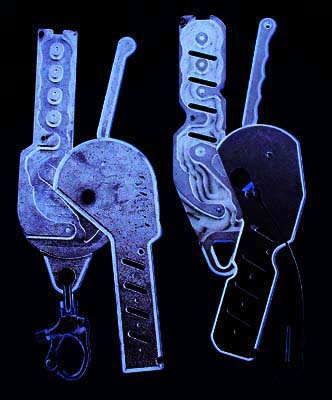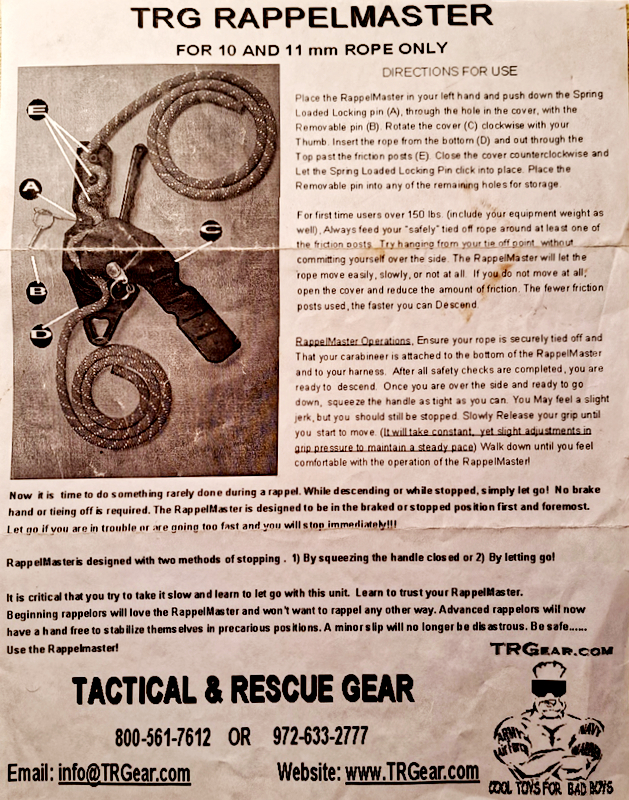Overview
History
The T&RG was copied from the Omer 1, but there are many small differences. The most significant external differences are the eye on the T&RG replaces the quick-release swivel fitting on the Omer 1 (the swivel shown on this descender was probably added later), the T&RG provides a push-pin for securely closing the cover and for releasing the spring-loaded pin, and the Omer 1 is painted while the T&RG is anodized. The following false-color image shows the internal differences. The Omer 1 has five bollards while the T&RG has four. Only one of the Omer 1 bollards has a fence, so there are sixteen ways to rig the Omer 1 versus four for the T&RG (not that this matters much). There are minor differences in the control lever and rope channel shapes. Most significantly, the T&RG will handle 11 mm. rope while the Omer 1 will only accept 9 mm. line - yet the T&RG weighs less than 60% of the Omer 1’s weight.

[ Top
| Version B
| Version C
| Version D
| Return to Lever Boxes
]
Version A
(#1017)
Technical Details
I acquired this TRG descender from Aric Schoonover in 2006.
Version A is 330 mm. tall, 107 mm. wide, 51 mm. thick, and weighs 1064 g.
Version A is designed for 9 mm. rope, not 11 mm. rope, so the dimensions are not the same as the others. For
example, the following dimensions differ:
- The body cutout is 13.5 mm. deep.
- The upper "chimney" portion bollards lie on 24 mm
centers.
- From top to bottom, the bollards are 12.5/14.0, 12.5/14.0, 12.5/14.0 and 12.9/14.7 mm. in diameter, where the first number is minimum diameter where the rope runs and the second is the diameter at the outer end.
- There is less clearance between the projections on the control leaver and the corresponding points on the body.
- The chimney is narrower and shorter.
- The control leaver is shorter.
- The lower part of the body is larger.
- The control lever pivot heads are chamfered.
There are a number of other minor differences as well, such as the following:
- The third bollard lacks a fence.
- The rounded edges on the body and handle of Version B are somewhat larger than the corresponding ones on Version A, and they blend better with the rear surface of the body.
- The internal edges of the eye are not rounded.
- The anodized finish is glossy rather than flat.
- There is no teardrop or cable to hold the upper push pin.
- There rear spring-loaded round-tipped pin is held by a set screw. The spring is missing.
- There is a clevis with an attached rotating eye attached to the body eye.
- There are no words marked on the back of the frame other than "TRG 9-105," and this appears to have been added
by a previous owner, not the factory.
- There is a clevis and rotating eye attached to the lower attachment hole.
I doubt that the lower clevis and rotating eye are original equipment, since the lower hole is subtriangular and does not fit the clevis pin. On the other hand, this hole does not have rounded edges.
[ Top
| Version A
| Version C
| Version D
| Return to Lever Boxes
]
Version B
(#917)
Technical Details
I acquired this Tactical & Rescue Gear (T&RG)
descender from Charles Barchuk in 2002.
Version B is 266 mm. tall, 103 mm. wide, 37 mm. thick, and weighs 630 g.
The T&RG is made from three pieces of milled anodized aluminum - body, control lever, and front plate - and several minor stainless steel components. The body is made from 19.4 mm. aluminum milled to a tall irregular shape. The lower portion of the body has a subtriangular eye that can accept a single carabiner. The edges of the eye are rounded with a 3.5 mm. radius. This small radius leaves one with the impression that the eye is somewhat "blocky," but not to the extent as the eye on the SALS Rappeller. The main portion of the body has a 15.6 mm. deep milled cutout for the rope path and lever assembly. The upper "chimney" portion has four milled bollards on 27.8 mm. centers, with a 15.5 to 16 mm. rope channel around each. From top to bottom, the bollards are 12.0/13.0, 12.0/13.0, 11.0/11.9 and 11.2/12.1 mm. in diameter, where the first number is minimum diameter where the rope runs and the second is the diameter at the outer end. The top two bollards are circular so the rope can pass on either side of each (four possible combinations), but the lower two have fences that force one to run the rope around the lower bollards. Below the lowest bollard, the rope follows an "S" shaped path around a non-circular projection on the control lever and a 12 mm. diameter corner milled into the frame. The rope then leaves the left side of the T&RG at a 90° angle.
The control lever and front plate pivot on an 8(?) mm. stainless steel bolt. The control end extends upward along the right side of the chimney. This end has a rounded-square cross section with five wide, shallow finger-grooves on the outer side. A small hole near the top end probably served as an alignment hole for machining. The working end of the lever has two projections. The rope runs around the upper one as mentioned in the preceding paragraph. Squeezing the lever against the handle causes this projection to force the rope against a curved cutout milled in the frame. During use, the rope friction against the upper projection will cause the lever to open. When this happens, a concave surface in the lower projection forces the rope against the 12 mm. corner. The inside surface of the cover plate is milled to a depth of 2.5 mm. to match the milling on the body. The edges of the cover milling are beveled.
The front plate covers the rope channel and working end of the lever. Four slots in the cover and four more in the back of the frame allow mud to escape. There is a small slot at the top left-hand corner of the cover that engages a hex socket-head cap set in the frame. This screw was so loose that I had to epoxy it in place to prevent losing it. Three holes drilled through cover plate align with holes centered in the top three bollards, and a fourth hole aligns with a hole at the center of the 12 mm corner. Any of these accept a 4.8 mm. diameter push pin to keep the front plate closed during use. The pin is attached to a tab on the pivot bolt by a stainless steel cable and a large split ring. A fifth hole near the left-hand base of the chimney aligns with a spring-loaded round-tipped pin in the frame. A hex-head cap screw in the back of the frame holds the pin and spring in place. The pin automatically engages when the cover is closed. To release it, one needs a small sharp object to depress the pin (the push pin works for this task).
The back of the frame is marked with "Tactical and Rescue Gear," the U. S. A. phone number "800-561-7612," and the URL "www.TRGear.com."
The T&RG is a nicely-made lever box, with the exception of the head on the handle pivot, which on this version has a substantial burr.
The TR&G provides the ability to vary friction by changing the number of top bollards in use; however, the decision must be made before starting the descent. Lock off is positive on the ropes that I tried, and the long control lever makes controlling rather easy.
Be careful not to let the cover try to close from the wrong side. When this happens, the spring-loaded pin engages the milled cutouts on the inside of the cover, where it can be difficult to release.

[ Top
| Version A
| Version B
| Version D
| Return to Lever Boxes
]
Version C
(#1018)
Technical Details
I acquired this TRG descender from Aric Schoonover in 2006.
Version C is 266 mm. tall, 103 mm. wide, 39 mm. thick, and weighs 685 g.
Version C is essentially the same size and shape as Version
B. The differences are as follows:
- The body cutout is 15.1 mm. deep.
- From top to bottom, the bollards are 12.7/14.0, 12.7/14.0, 12.7/14.0 and 13.0/14.2 mm. in diameter, where the first number is minimum diameter where the rope runs and the second is the diameter at the outer end.
- The rounded edges on the body and handle of Version C
are somewhat larger than the corresponding ones on Version B,
and they blend better with the rear surface of the body.
- Version C did not have a cable keeper for the push pin.
- The handle on Version C pivots on a 3/8-in x 1-in hex
cap headed axle bolt with a 5/16-18 UNC thread. A common hex
nut holds it in place. This may not be original equipment.
- It was missing the rear spring-loaded round-tipped pin and associated
cap screw, so I made a pin and added a spring and cap screw to restore this functionality.
- There was no hex socket-head cap set in the frame to engage
the small slot at the top left-hand corner of the cover, so I added one.
The back of the frame is marked with "Tactical and Rescue Gear," the U. S. A. phone number "800-561-7612," and the URL "www.TRGear.com."
I imagine that most of the missing pieces in this version originally
existed but disappeared.
[ Top
| Version A
| Version B
| Version C
| Return to Lever Boxes
]
Version D
(#2572)
Technical Details
I acquired my Tactical & Rescue Gear, Version D from David Domina in 2020.
My Tactical & Rescue Gear, Version D is 269 mm. tall, 102 mm. wide, 41 mm. thick, and weighs 636 g.
Version D is similar to Version C, the main difference being that the handle pivots on a stainless steel bolt similar to that in Version B, except the head on Version D is taller and smaller in diameter. It has a small burr on the corners.
The bollards are smaller as well, like those on Version A. From top to bottom, the bollards are 12.0/13.0, 12.0/13.0, 11.0/11.9 and 11.2/12.1 mm. in diameter, where the first number is minimum diameter where the rope runs and the second is the diameter at the outer end.
The back of the frame is marked with "Tactical and Rescue Gear," the U. S. A. phone number "800-561-7612," the URL "www.TRGear.com," and "Rev A."
See the Omer 1 page for some of the history behind the TR&G.
[ Top
| Version A
| Version B
| Version C
| Version D
]

